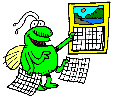
University of Kentucky Department of Entomology







Entfact 805Insect Art and OrnamentsBy
Lana Unger,
|
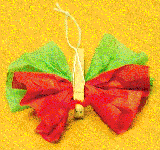 L. Unger 1998 |
|
Cut tissue paper into six inch squares. Take two squares of tissue paper, (different colors), and gather them along the center to make thewings of the butterfly. Glue the gathered center into the clothespin. 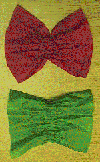
L. Unger 1998- Fan out the edges of the paper.
- Cut the
pipe cleaners into two equal pieces. Take one half of the pipe cleaner and fold it in half.
Glue the middle of the pipe cleaner to the top of the clothespin to make the antennae.
Make small hooks at the ends of the antennae. 
L. Unger 1998 - Use markers to draw eyes.
- A string can be glued or tied to the butterfly to make an ornament or a magnet could be glued on to the underside of the clothespin to make refrigerator art.
Egg Carton Caterpillars
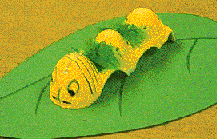 L. Unger 1998 |
|
- Cut the egg carton into smaller pieces, (three cells in each piece makes a good-sized caterpillar).
- Turn the pieces over so that the humps face up.
- Use markers or paint to color the caterpillars crazy colors.
- Toothpicks, feathers and glitter can be glued on to create hair and spikes. Look at pictures of bizarre caterpillars, such as Hickory Horned Devil, Banded Woollybear and Saddleback caterpillars to get ideas.
Ladybugs and Scarabs
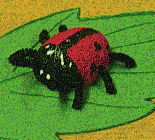 L. Unger 1998 |
|
- Cut the Styrofoam eggs in half, lengthwise.
- Paint the styrofoam to look like a beetle.
- Cut the pipecleaner into one inch long pieces.
- Glue the pipe cleaner pieces into the styrofoam to make legs and antennae.
Mosaic Butterflies
- Things you will need:
- Construction paper (various colors)
- Hole punch
- Markers
- Glue
- Use the hole punch to make lots of small disks of different colored construction paper.
- Draw an outline of a butterfly on a piece of construction paper.
- Glue the colored disks of paper to the butterfly, overlapping the edges slightly to create interesting mosaic patterns on the wings of your butterfly.
Butterfly wings have all different patterns and colors. If you have ever tried to hold a butterfly, you know that when you touch its wings, a fine colored powder rubs off onto your hands. The powder is actually very small scales of all different colors. The scales are attached to the wings in neat overlapping rows creating stripes and circular patterns. The colored disks of paper are like the scales on a real butterfly's wings. Individually, they don't look like much, but when there are lots of them together they create all sorts of patterns and shapes.
Insects All Year cartoon courtesy of C. Ware, copyright 1998
Photographs courtesy of Lana Unger, University of Kentucky Department of Entomology
Last updated: 21 January 1999
 Return to UK Department of Entomology Katerpillars page
Return to UK Department of Entomology Katerpillars page Return to UK Department of Entomology homepage
Return to UK Department of Entomology homepage Return to University of Kentucky homepage
Return to University of Kentucky homepage